frunze rasucite
- Autor subiect MASCHA
- Dată pornire
poze clare pe ambele suprafete ale frunzei ?
anasstasia
Active Member
Si a mea a avut (are) aceiasi problema. Oricum stagneaza in crestere, nu stiu ce-i cu ea.
MASCHA
Active Member
Am facut cateva poze plantelor cu probleme
http://mascha.sunphoto.ro/plante_cu_probleme/77049490
http://mascha.sunphoto.ro/plante_cu_probleme/77049493
Imi pare rau dar mai clare de atat nu am cum sa le fac,deocamdata
http://mascha.sunphoto.ro/plante_cu_probleme/77049490
http://mascha.sunphoto.ro/plante_cu_probleme/77049493
Imi pare rau dar mai clare de atat nu am cum sa le fac,deocamdata
destul de neclara situatia , parca e un tablou de Picasso :incapatanat: :nu-i nimic:
Totusi frunzele intoarse in jos dovedesc un atac extern al cuiva ,
Cauze pot fi multiple , udari neregulate , insuficiente sau chiar abuzive pe un timp prea lung , atacuri de insecte , paianjeni in special dar si paduchele testos de multe ori , lumina insuficienta sau expunerea unor plante de semiumbra la soare puternic
Deasemenea , plantele care beau multa apa tind sa solidifice sarurile din sol prin uscarea lui repetata , prezente prin depuneri pe marginea vasului si acestea trebuiesc neaparat schimbate cu sol proaspat
Dieffenbachia are si un virus la activ doar ca acesta se maniifesta printr-un mozaic aparent pe frunze pentru a fi usor identificat
In caz ca nu e vorba de "daunatori sau virusi" trebuie analizat modul de udare si de hranire , prea multa apa si prea putina si acelasi lucru valabil si la ingrasaminte pot dauna plantei
o zi buna va doresc si plante sanatoase
Totusi frunzele intoarse in jos dovedesc un atac extern al cuiva ,
Cauze pot fi multiple , udari neregulate , insuficiente sau chiar abuzive pe un timp prea lung , atacuri de insecte , paianjeni in special dar si paduchele testos de multe ori , lumina insuficienta sau expunerea unor plante de semiumbra la soare puternic
Deasemenea , plantele care beau multa apa tind sa solidifice sarurile din sol prin uscarea lui repetata , prezente prin depuneri pe marginea vasului si acestea trebuiesc neaparat schimbate cu sol proaspat
Dieffenbachia are si un virus la activ doar ca acesta se maniifesta printr-un mozaic aparent pe frunze pentru a fi usor identificat
In caz ca nu e vorba de "daunatori sau virusi" trebuie analizat modul de udare si de hranire , prea multa apa si prea putina si acelasi lucru valabil si la ingrasaminte pot dauna plantei
o zi buna va doresc si plante sanatoase
atunci planta are un virus sau radacina e defectuoasa 
de multe ori nu , dar se poate vindeca cu fungicide sistemice de control
ce e rau e ca daca ai sau este demonstrat virus , ai sansa daca vine o insecta ce se hraneste din ea sa distribuie si la alte plante
ce e rau e ca daca ai sau este demonstrat virus , ai sansa daca vine o insecta ce se hraneste din ea sa distribuie si la alte plante
georgy03021993
Member
Asa am patit si eu cu Syngonium. Cred ca din cauza aerului uscat. Acum o pulverizez de cateva ori pe zi si a facut frunzele mai mari. Am avut soiul cu frunze palmate, dar s-au facut obisnuite 
Roxana
Active Member
Aceeasi problema o am si eu si nu numai la Dieffenbachia, ci si la Kohleria. Eu le ud cam de doua ori pe saptamana. Sa fie insuficient sau este vorba de vreo carenta a solului? (pe Kohleria de exemplu nu o pot pulveriza)
O sa atasez si niste poze:
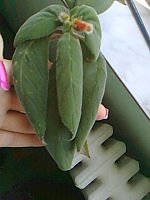
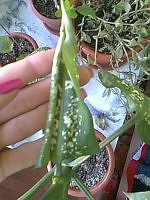
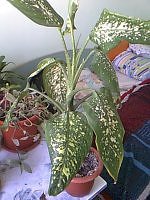

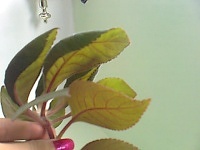
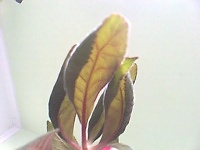
Cel putin Dieffenbachia asta mica sta de ceva timp asa:
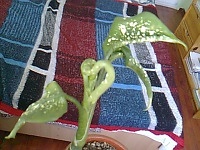
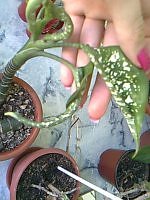
Si aceasta Kalanchoe are aceeasi problema. Are frunzele stanse ca intr-un buchet. (pe ea o ud cam o data pe saptamana, gandindu-ma ca este o suculenta)Aceeasi problema si la Tradescantia violaceae. (frunzele rulate spre interior):




Daunatori nu par sa aiba, m-am uitat la frunze...si nimic.
O sa atasez si niste poze:






Cel putin Dieffenbachia asta mica sta de ceva timp asa:


Si aceasta Kalanchoe are aceeasi problema. Are frunzele stanse ca intr-un buchet. (pe ea o ud cam o data pe saptamana, gandindu-ma ca este o suculenta)Aceeasi problema si la Tradescantia violaceae. (frunzele rulate spre interior):




Daunatori nu par sa aiba, m-am uitat la frunze...si nimic.
nu am timp sa traduc , dar te descurci tu
Leaf curl/cupping & leaf margin rolling-signs of Plant Moisture Stress
Quite often I hear groans from folks having leaf problems -> “Help, my leaves are cupping and the leaf edges are turning brown!”, or, “My plant's leaf tips are curling down and turning black ....what's wrong?” Unless insect damage has occurred or the plant is suffering from a severe case of calcium deficiency, the plant is trying to tell you that it is water stressed. It's hard to tell *exactly* what the culprit is, and unfortunately the “solution” the grower chooses many times is not the right one. A mis-diagnosis only serves to make matters worse by promoting further decline. I’ll try to cover some of the more common causes that can induce these common symptoms and try to offer a few simple solutions. The ultimate and correct solution is in the hands of the grower.
1. Over-fertilizing - the most common cause of leaf cupping aka leaf margin rolling, leaf margin burn, and leaf tip curl/burn is the overzealous use of too much plant food in relationship to factors such as plant vigor and rate of growth. The first unit of a plant to show moisture stress is the leaf at its margins and/or tips, reflected by margin rolling (cupping) or burning. A hard, crispy feel to the leaf frequently occurs as well, as opposed to a soft and cool feel of a happy leaf. When you have a high concentration of salts in solution (in the root medium) compared to the salinity levels found in the plant’s tissue, water is actually drawn out of the plant across the root gradient in order to fix the ppm imbalance. IOW, this is a natural, osmotic response that serves to equalize salinity levels on both sides of the root’s epidermal gradient. Back off on the amount and/or frequency of plant food. Too much plant food can also burn the roots, especially the sensitive root tips, which then creates another set of problems. Note - as soil dries, the concentration of the remaining salts rises further exacerbating the problem.
2. High Heat - the plant is losing water via it’s leaves faster than what can be replaced by the root system. The leaf responds by leaf margin cupping or rolling up or down (most times up) in order to conserve moisture. A good example is reflected by the appearance of broad-bladed turf grass on a hot summer day, high noon, with low soil moisture levels - the leaf blade will roll upward/inward with the grass taking on a dull, greyish-green appearance. Upon sunrise when moisture levels have returned to normal, the leaf blade will be flat. Lower the heat and concentrate on developing a large, robust root system by practicing sound plant culture. An efficient and effective root system will go a long way to prevent heat induced leaf dessication and leaf margin curling. One short episode of high heat is enough to permanently disable or destroy leaf tissue and cause a general decline in the leaves affected, which often occurs to leaves found at the top of the plant. The damaged leaf (usually) does not fully recover, no matter what you do. Bummer in the summer. One can only look to new growth for indications that the problem has been corrected.
3. High Light - yes, it’s true, you can give our faves too much light. Cannabis does not receive full sun from sunrise to sunset in its natural state. It is shaded or given reduced light levels because of adjacent plant material, cloudy conditions, rain, dust, twilight periods in the morning and late afternoon, and light intensity changes caused by a change in the seasons. Too much light mainly serves to bleach out and destroy chlorophyll as opposed to causing leaf cupping, but it often goes hand-in-hand with high heat for indoor growers. Again, back off on the light and concentrate on developing/maintaining an efficient and robust root system.
4. Overwatering - for those doing soil, this practice only serves to weaken the root system by depriving the roots of proper gas exchange. IOW, the roots are not getting enough oxygen which creates an anerobic condition inducing root rot and root decline with the end result showing up as leaf stress, stunted growth, and in severe cases, death. <gasp!> Overwatering creates a perfect environment for damp-off disease, at, or below the soil line. Alot of times folks think the plant is not getting enough plant food (which it can't under such adverse conditions), they add more nutes for a "curative", and just add insult to injury.
5. Underwatering - not only is the plant now stressed due to a low supply of adequate moisture, but carbohydrate production has been greatly compromised (screwed up). Step up the watering frequency, and if need be, organic growers may need to water from the bottom up until moisture levels reach a norm throughout the medium. If the pot feels light to the lift - it’s time to water. Don’t wait until the soil pulls away from the sides of the pot or leaves droop before you water. And of course, leach once in a while to get rid of excess salts.
All of the above issues relate to a plant's internal cell turgor or cell water pressure. If water pressure within the plant's stem and leaf cells are positive, the plant will look strong and stocky with flat leaves that are cool to the touch due to good transpiration from the leaf surface. By the same token, if the water pressure is not up to par, whereby water is being extracted from the plant and not replenished like it should be.... the leaves and/or stems will droop.
Leaf curl/cupping & leaf margin rolling-signs of Plant Moisture Stress
Quite often I hear groans from folks having leaf problems -> “Help, my leaves are cupping and the leaf edges are turning brown!”, or, “My plant's leaf tips are curling down and turning black ....what's wrong?” Unless insect damage has occurred or the plant is suffering from a severe case of calcium deficiency, the plant is trying to tell you that it is water stressed. It's hard to tell *exactly* what the culprit is, and unfortunately the “solution” the grower chooses many times is not the right one. A mis-diagnosis only serves to make matters worse by promoting further decline. I’ll try to cover some of the more common causes that can induce these common symptoms and try to offer a few simple solutions. The ultimate and correct solution is in the hands of the grower.
1. Over-fertilizing - the most common cause of leaf cupping aka leaf margin rolling, leaf margin burn, and leaf tip curl/burn is the overzealous use of too much plant food in relationship to factors such as plant vigor and rate of growth. The first unit of a plant to show moisture stress is the leaf at its margins and/or tips, reflected by margin rolling (cupping) or burning. A hard, crispy feel to the leaf frequently occurs as well, as opposed to a soft and cool feel of a happy leaf. When you have a high concentration of salts in solution (in the root medium) compared to the salinity levels found in the plant’s tissue, water is actually drawn out of the plant across the root gradient in order to fix the ppm imbalance. IOW, this is a natural, osmotic response that serves to equalize salinity levels on both sides of the root’s epidermal gradient. Back off on the amount and/or frequency of plant food. Too much plant food can also burn the roots, especially the sensitive root tips, which then creates another set of problems. Note - as soil dries, the concentration of the remaining salts rises further exacerbating the problem.
2. High Heat - the plant is losing water via it’s leaves faster than what can be replaced by the root system. The leaf responds by leaf margin cupping or rolling up or down (most times up) in order to conserve moisture. A good example is reflected by the appearance of broad-bladed turf grass on a hot summer day, high noon, with low soil moisture levels - the leaf blade will roll upward/inward with the grass taking on a dull, greyish-green appearance. Upon sunrise when moisture levels have returned to normal, the leaf blade will be flat. Lower the heat and concentrate on developing a large, robust root system by practicing sound plant culture. An efficient and effective root system will go a long way to prevent heat induced leaf dessication and leaf margin curling. One short episode of high heat is enough to permanently disable or destroy leaf tissue and cause a general decline in the leaves affected, which often occurs to leaves found at the top of the plant. The damaged leaf (usually) does not fully recover, no matter what you do. Bummer in the summer. One can only look to new growth for indications that the problem has been corrected.
3. High Light - yes, it’s true, you can give our faves too much light. Cannabis does not receive full sun from sunrise to sunset in its natural state. It is shaded or given reduced light levels because of adjacent plant material, cloudy conditions, rain, dust, twilight periods in the morning and late afternoon, and light intensity changes caused by a change in the seasons. Too much light mainly serves to bleach out and destroy chlorophyll as opposed to causing leaf cupping, but it often goes hand-in-hand with high heat for indoor growers. Again, back off on the light and concentrate on developing/maintaining an efficient and robust root system.
4. Overwatering - for those doing soil, this practice only serves to weaken the root system by depriving the roots of proper gas exchange. IOW, the roots are not getting enough oxygen which creates an anerobic condition inducing root rot and root decline with the end result showing up as leaf stress, stunted growth, and in severe cases, death. <gasp!> Overwatering creates a perfect environment for damp-off disease, at, or below the soil line. Alot of times folks think the plant is not getting enough plant food (which it can't under such adverse conditions), they add more nutes for a "curative", and just add insult to injury.
5. Underwatering - not only is the plant now stressed due to a low supply of adequate moisture, but carbohydrate production has been greatly compromised (screwed up). Step up the watering frequency, and if need be, organic growers may need to water from the bottom up until moisture levels reach a norm throughout the medium. If the pot feels light to the lift - it’s time to water. Don’t wait until the soil pulls away from the sides of the pot or leaves droop before you water. And of course, leach once in a while to get rid of excess salts.
All of the above issues relate to a plant's internal cell turgor or cell water pressure. If water pressure within the plant's stem and leaf cells are positive, the plant will look strong and stocky with flat leaves that are cool to the touch due to good transpiration from the leaf surface. By the same token, if the water pressure is not up to par, whereby water is being extracted from the plant and not replenished like it should be.... the leaves and/or stems will droop.
Roxana
Active Member
Multumesc mult pentru raspuns.
Da, am inteles cam care ar putea fi cauzele. Voi incerca sa le ud mai des si regulat sa vad daca se va observa vreo imbunatatire. Daca nu, am inteles ca poate fi vorba si despre o carenta de calciu. Eu ud plantele cu apa de la robinet, pe care o las la decantat o zi-doua. Cum pot rezolva problema cu lipsa de calciu?
Da, am inteles cam care ar putea fi cauzele. Voi incerca sa le ud mai des si regulat sa vad daca se va observa vreo imbunatatire. Daca nu, am inteles ca poate fi vorba si despre o carenta de calciu. Eu ud plantele cu apa de la robinet, pe care o las la decantat o zi-doua. Cum pot rezolva problema cu lipsa de calciu?
Nicasol e cel care ajuta daca esti FERM convinsa ca el e cel care lipseste altfel face mai mult rau decat bine in exces 
principal nu e sa cauti cauza cu udatul ci cu fiertul radacinilor expuse la soare , frunza rasucita in jos inseamna apa putina in vasele de transport si radacina care e chinuita din doua motive , apa prea multa in sol - radacini firave si fara putere de racorire si pamant prea tasat deci lipsa de oxigen
pamantul de gradina in ghivece e moarte totala la caldura , incearca un sol aerat de tip gata-facut in care sa adaugi perlit sau pietris de dim 3-5 mm maxim, pamant - agregate = 3:1
